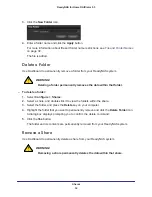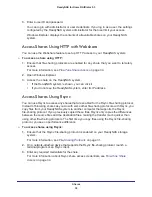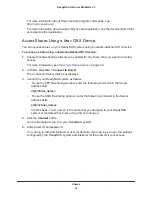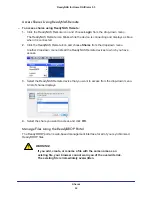
Users and Groups
49
ReadyNAS for Home RAIDiator 5.3
Basic User and Group Concepts
Users are the people to whom you grant access to your storage system. If your company
uses Windows Active Directory, you can use that to manage ReadyNAS users. Otherwise,
when you want to allow someone to access your ReadyNAS system, you create a user
account for that person. The ReadyNAS storage system administrator sets up user accounts
and decides which shares each user is permitted to access.
If your ReadyNAS storage system is used at home, you might create a user account for each
member of the family, but allow only the parents to access financial data stored on your
system. You might decide that all user accounts can access photos and music stored on the
system. You can set the appropriate permissions for each user.
The ReadyNAS system administrator can set up groups to make it easier to manage large
numbers of users. For example, if your ReadyNAS storage system is being used in a
business, you might decide that every employee should have a user account. However, you
might decide that only users in the accounting department can access information in the
accounting share, but that all users can access data stored in the company benefits share.
You can create a group for each department and place all users in the appropriate group or
groups.
User and Group Account Limitations
You can create up to 32,000 user accounts on your ReadyNAS storage system. However,
creating many accounts on your system can degrade its performance, so NETGEAR
recommends that you create and maintain only those accounts you need, preferably fewer
than 100.
When you add user, a private home share is created for that user. This private home share is
visible only to the user and the system administrator.
User and Group Management Modes
Your ReadyNAS system offers to methods for managing user and group accounts:
•
Local Users mode
. This is the default mode, which allows you to manually manage user
and group accounts.
•
Active Directory mode
. This mode requires an Active Directory database.
















































